Path of the Kirksville Cyclone, 1899
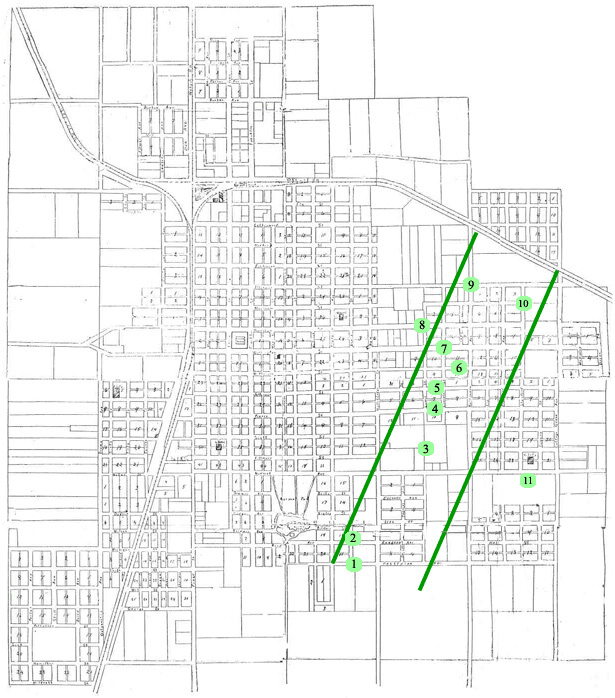
Wallin’s Kirksville Directory for 1899-1900.
Locators: Each number on the directory to the left has a corresponding tab below. Click the tabs for further information and photos from each site.
The tornado first touched down in the city proper on East Patterson and demolished the three homes on the south side of the street between Florence and Thomas. Mrs Nannie Bailey’s boarding house at 516 is shown as it appeared before (first photo) and after the storm (second photo).
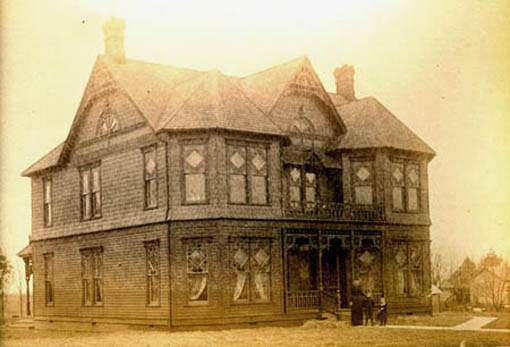
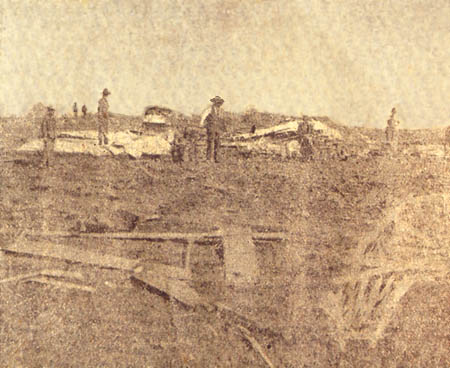
The rubble in the foreground, which may be a little difficult to make out, is what was left of her organ and a chair. In the next block, William Bragg’s farm home and a large shade tree were left in splinters. The storm claimed it’s first in-town fatality between and across the street from the Bailey and Bragg houses. It was reported that Mrs Mary Mahaffey was found under an apple tree on the northwest corner of the Patterson-Davis intersection. The Patterson Fruit Farm was hit hard as well.
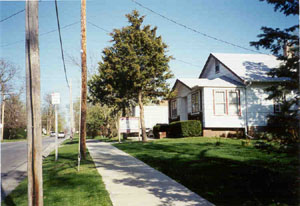
Arthur Patterson’s home at 708 (below), other buildings on the farm and a good portion of the orchard were either gone or damaged beyond repair.


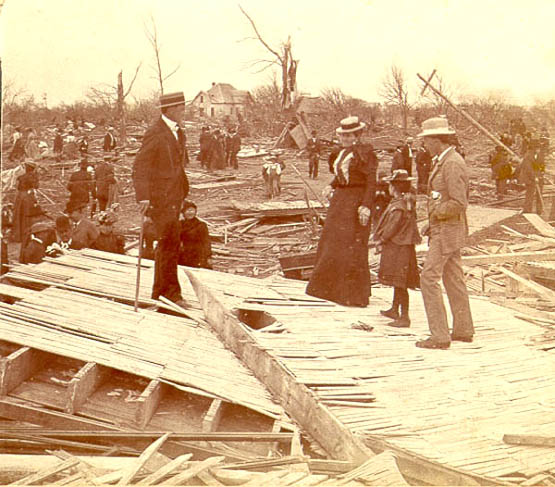
Mrs Mary Hensley lost her beautiful home on Randolph between Davis and Halliburton but her family thankfully made it to the storm cellar and were not injured. The next day she and her daughter stood on the wreckage of her house with sight seers and a visiting photographer. A block west, at the corner of Randolph & Florence, Mrs Phoebe Richter lost her home and boarding house as well. Andrew and Emma Bowman were not so lucky. Their home at 702 E Randolph, a block east of the Hensleys, was spared but Mrs Bowman was fatally injured. The Bowman house appears in the background of Mrs Hensley’s picture and is the subject of the second photo below.
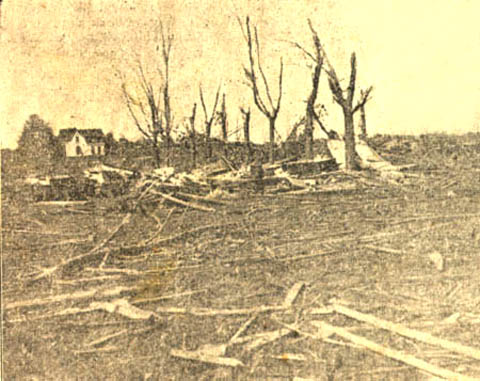
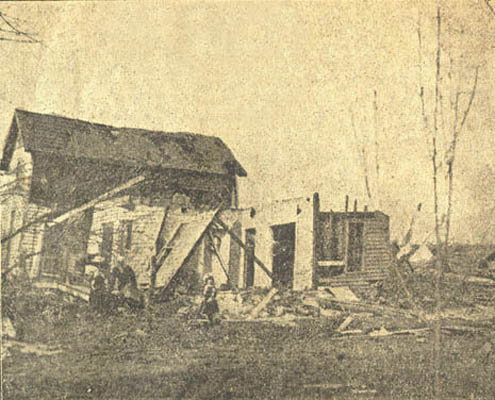
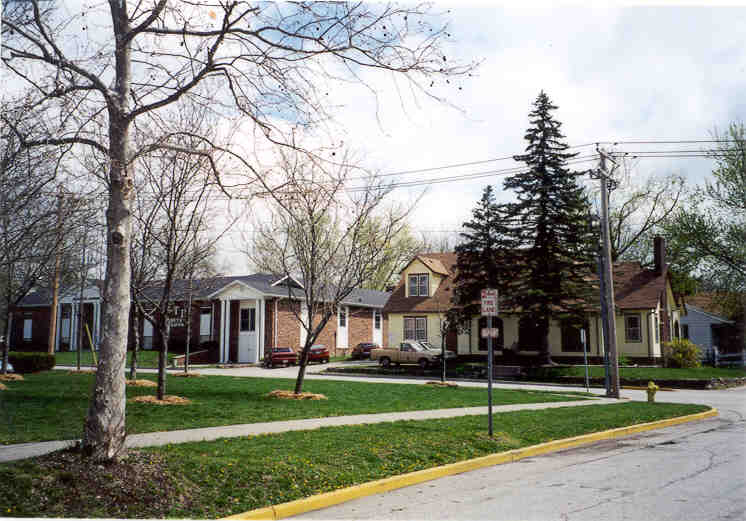
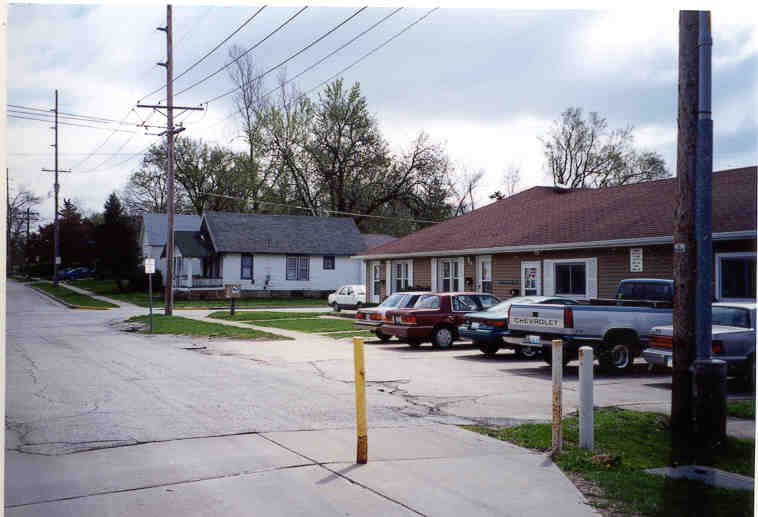
The homes of Theodore Brigham (below) and William M Hull were back-to-back on adjoining properties, Brigham’s looking south on Normal and Hull’s north on Scott. Brigham’s wife and son were severely injured and he was killed when the storm picked him up out of his house and slammed him back to earth, face down in the mud some distance away. The home was totally destroyed.
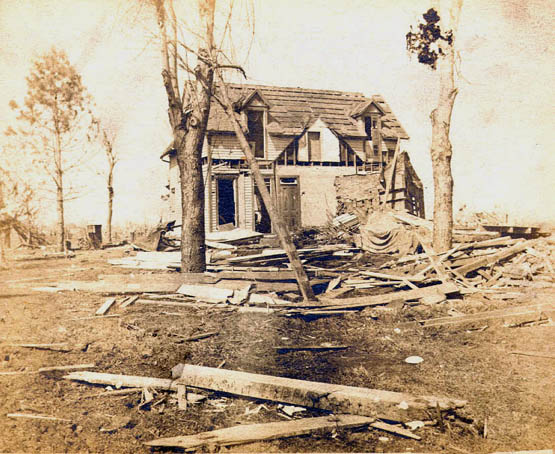
Hull and his wife escaped injury even though they were in their house when it was lifted from the foundation and moved north about 15 feet. Every window in the house was broken. Sightseers stand on what is left of Brigham’s house (first photo below) and Hull’s re-positioned home can be seen in the background. The other photo (second photo below) was taken a year after in April 1999.

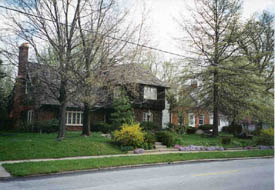
J T Coonfield’s house (below) in the 1000 block, just off Baltimore, was lifted from its foundation, blown 100 feet across a ditch and slammed into the side of a hill.
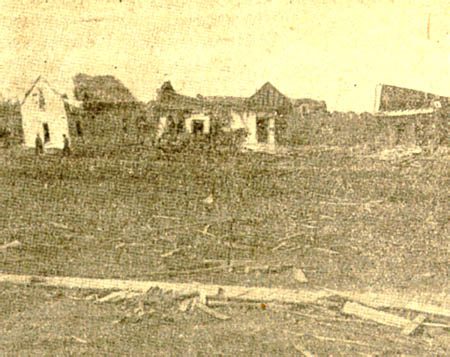
The only injury to the four women inside, including one suffering from typhoid fever, was a sprained ankle. The most gruesome of the fatalities occurred directly across the street at the home of Blue Panchott. He came home after the storm to find his wife and child had both been killed. Mrs Panchott had been decapitated. Nathan Speer’s house at 808 E Pierce (below) was picked up and hurled back to the ground in the same place.
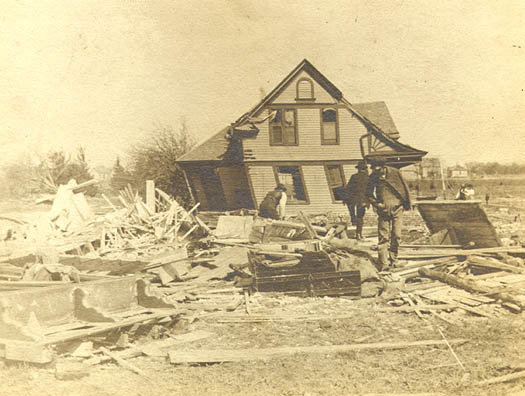
His gray horse was said to have been one of the several seen swirling about above the tree tops that evening. Below is a picture of the site in April 1999.
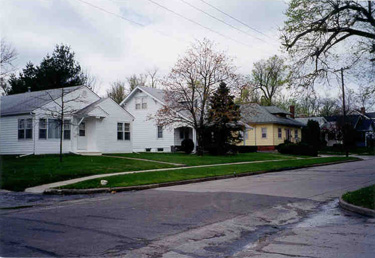
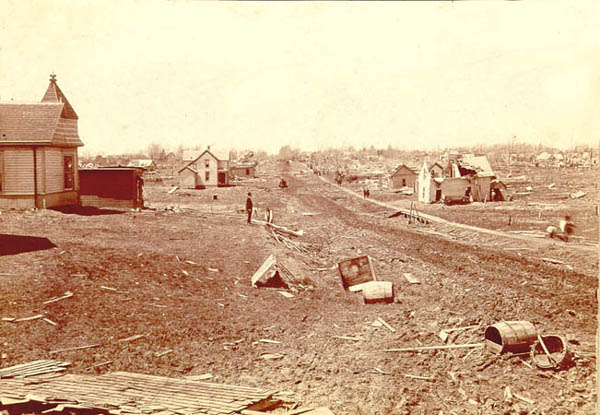
William Parke, the barber, and his family ran into the street when the storm struck. Mr Parke, with his small daughter under his arm, grabbed a tree and held on but the baby fell against him and was pinned under a pile of lumber. Mrs Parke and their boarder, Mrs Brown, were hurled around the house and into the branches of a tree that lay in the road. Heavy bruising was the extent of their injuries. And at the corner of Jefferson and Lincoln, John Anderson and his 6-week old infant escaped injury when he ran from the house (first photo below) and crawled under a small bridge on Jefferson. John’s wife, Della, didn’t get out in time and was badly hurt. In the next block east, at 906 E Jefferson, Mrs Hannah Braden and her family of seven were unhurt but their home (second photo below) was destroyed.
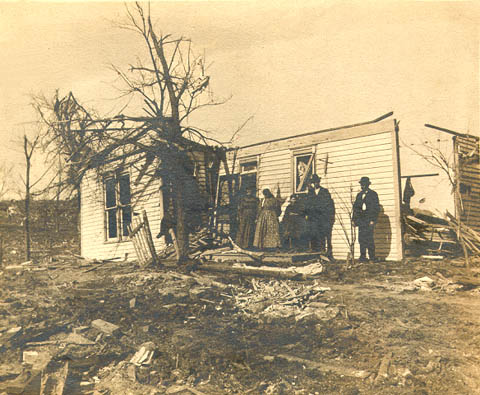

Again, the site is pictured in April 1999.
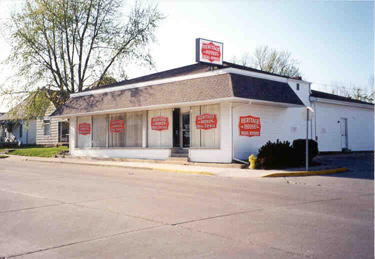
McPherson St, as is apparent by these photos, was a scene of total destruction. William B. Howells and H.K. Sherburne were neighbors in the 1000 block of McPherson and classmates at the American School of Osteopathy. Howells was killed, his wife and child injured. Rescuers took an injured Sherburne from the ruins then returned to search for his wife who, he said, was still “under there”. They finally found her, with a dead hen in her arms, beneath the remains of two buildings that had collided. She had a severe head wound and died as soon as she was placed beside her husband. (The Sherburnes didn’t keep chickens, by the way. It was thought the wind probably blew the hen onto Mrs Sherburne before the building collapsed over both.)Henry Billington, another ASO student, lost his wife and daughter a few blocks away in the 1300 block of E Harrison. A memorial service was held at the school on Sunday afternoon and “the Old Doctor” refunded that year’s tuition to all three families. Like the other sites, the bottom-most photo is from April 1999.
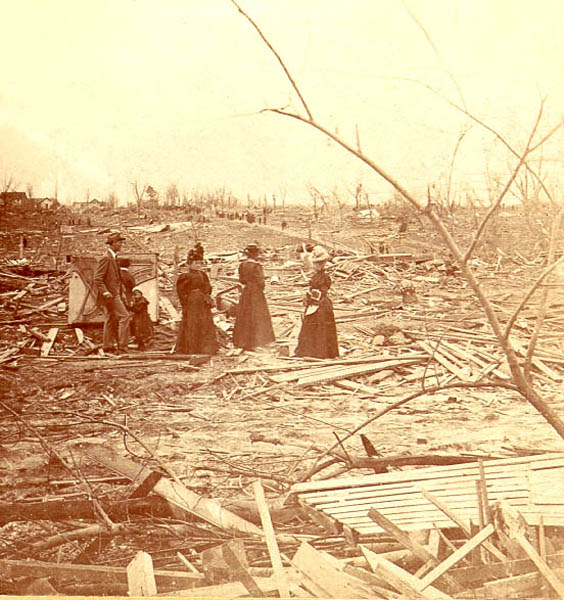
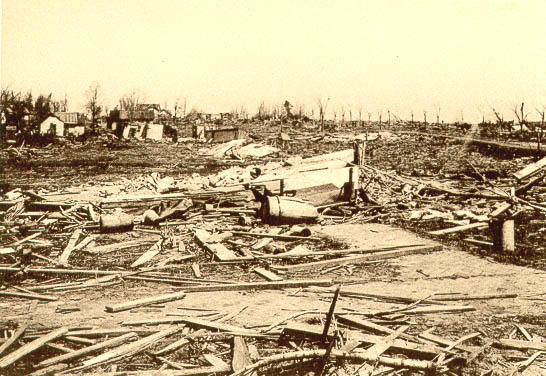
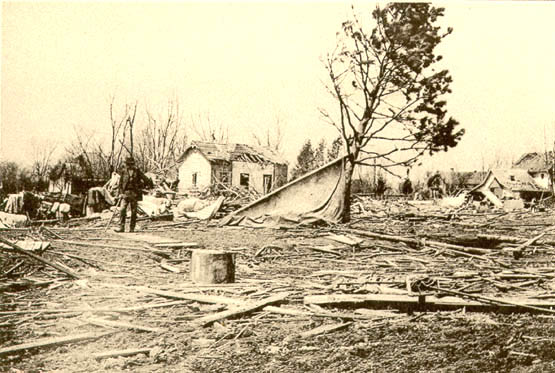
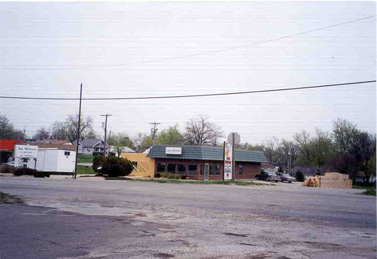
Photos taken in the 900 and 1000 blocks of E Washington show the extent of damage in the center of the hardest hit area of the city. Richard Hilt, who lived at 903 was on his way home from work and ran trying to beat the storm. He arrived to discover his wife and daughter safe in a neighbor’s cellar but his house and out buildings completely gone. Curiously enough, the family’s horse and pet canary were just fine. Joseph Musson, who lived in the 800 block, rushed his family out of the house before it was totally destroyed. The wind seized one of his daughters and was pulling her up, but he was able to grab her and pull her back from the storm’s suction. The whole family escaped unscathed.


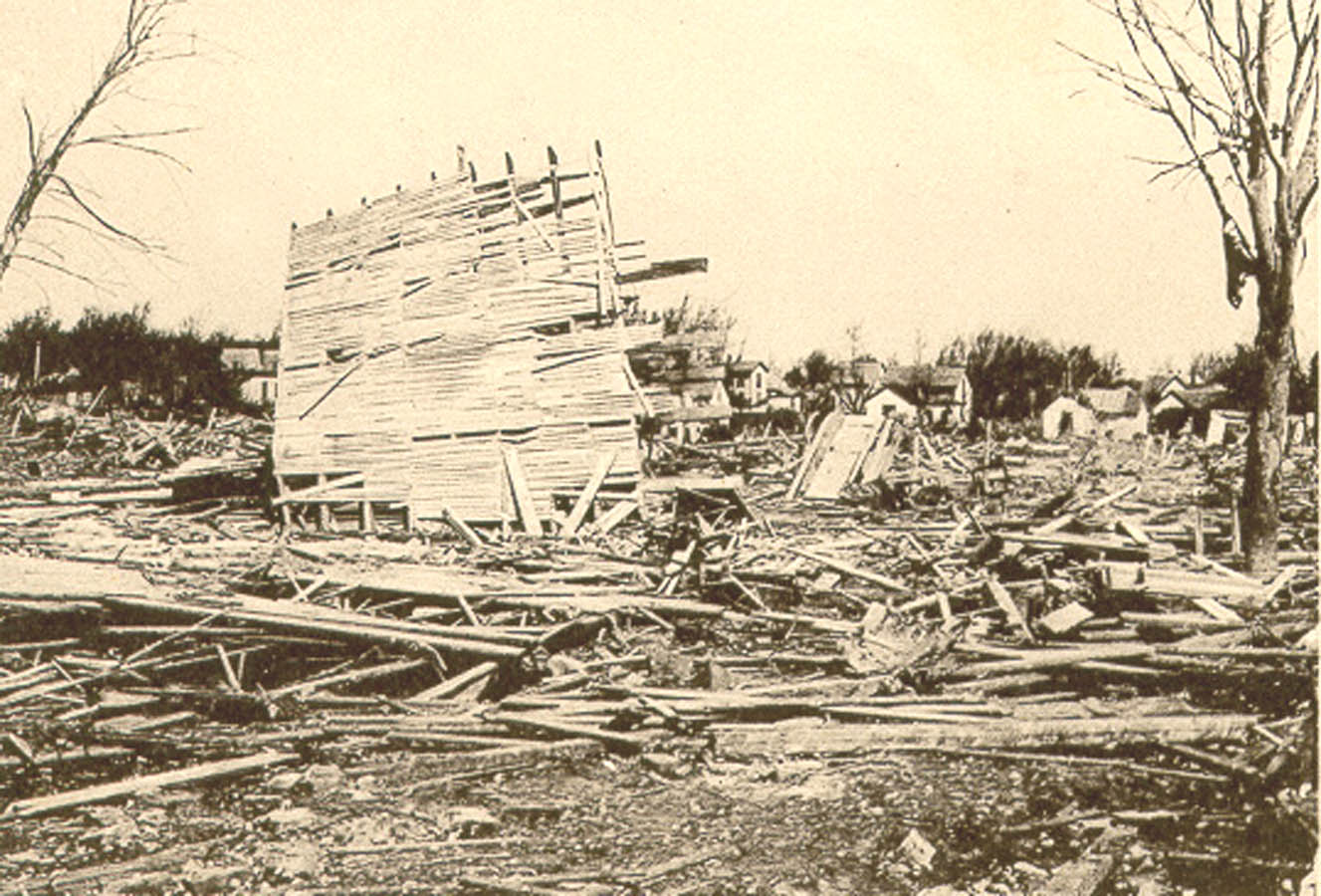

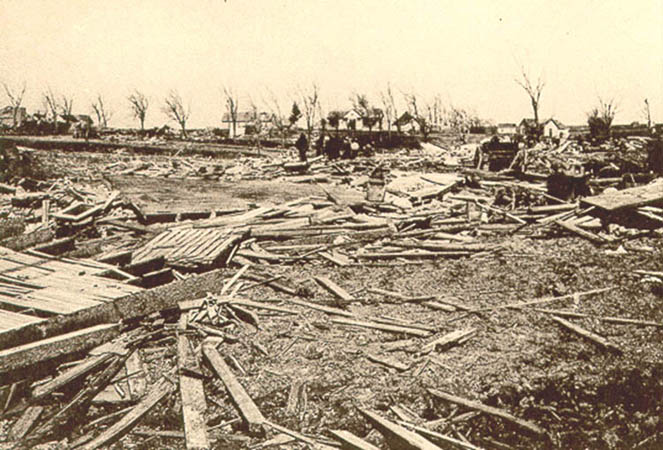
The homes of Robert Lorenz at 802 E Harrison (first photo) and former Mayor Thomas J Dockery at 904 (below right) were beautiful places before the storm struck.

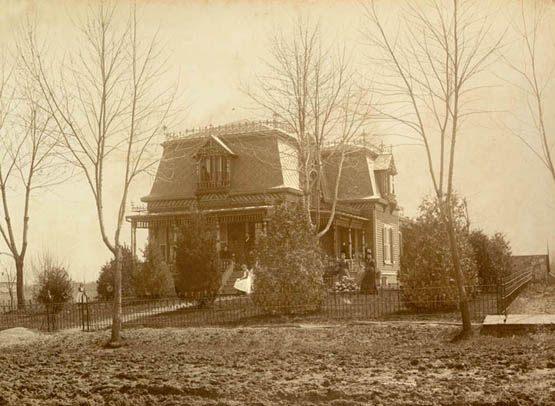
Both houses were damaged that evening but were spared total destruction. Mrs Dockery stood at her kitchen window and watched as their barn rolled over several times. The rear of her home and the block behind it, where the barn once stood, are in the large picture of East Washington St (No 7). The rest of the neighborhood didn’t fare quite so well. The bottom right photo was taken in April 1999.

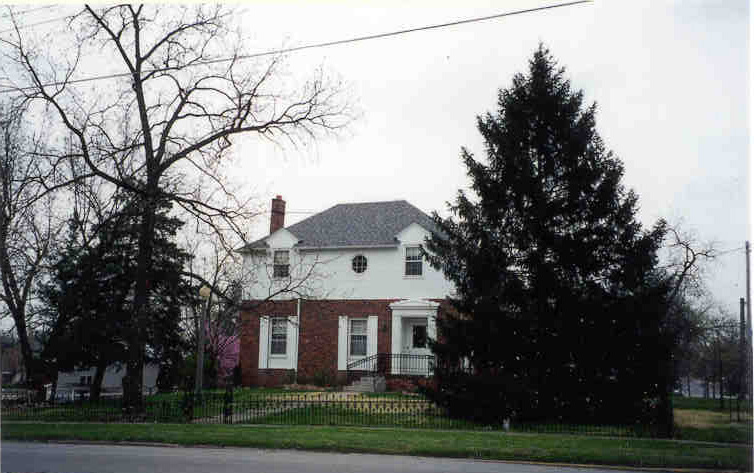
Judge & Mrs Andrew Ellison, northeast corner of the intersection, and guests were at dinner when they heard the roar. Everyone (even the cook who didn’t want to go and had to be bullied along by the Judge) made it into the cellar just as the upper portions of the house were swept away. All the out buildings were destroyed, and all that was left of a brand new ice house was a block of ice which was left standing exactly where it had been placed.Diagonally across the intersection, on the southwest corner, the John C Weaver family had elected to stay with their elderly father who was too feeble to leave. Miss Ella was cooking dinner when the wind turned the range over on her, breaking both legs and setting her clothing on fire. Neighbor Thomas Funk who had come to help carry the old man to safety, lifted the hot stove off her, extinguished the fire and carried Ella back to his home. He then returned for Mr Weaver but was too late to save him. Some versions of the story say Mr Weaver died in his own home, which was totally demolished; others say he died after being carried to the Funk house.


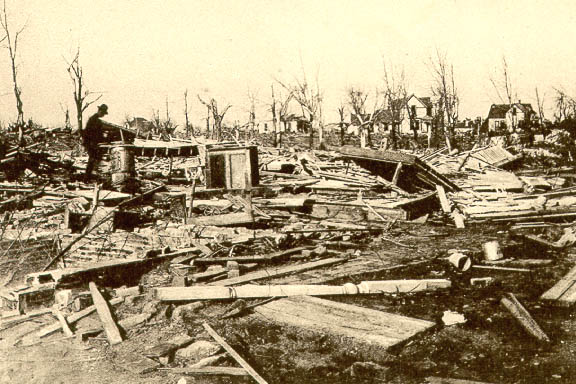
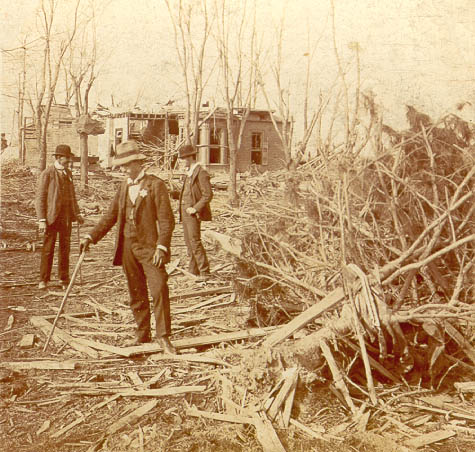
The first photo below is the northeast corner of the streets taken in 1999, and the other is the southwest corner, also taken in 1999.
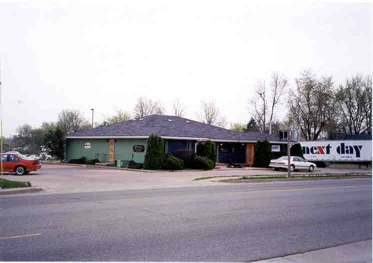
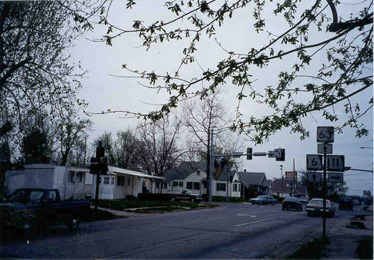
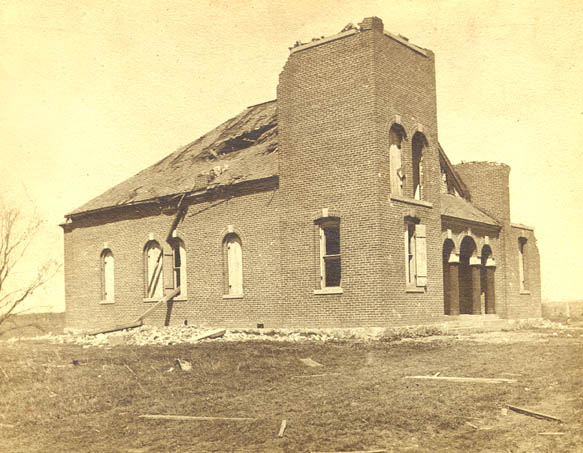
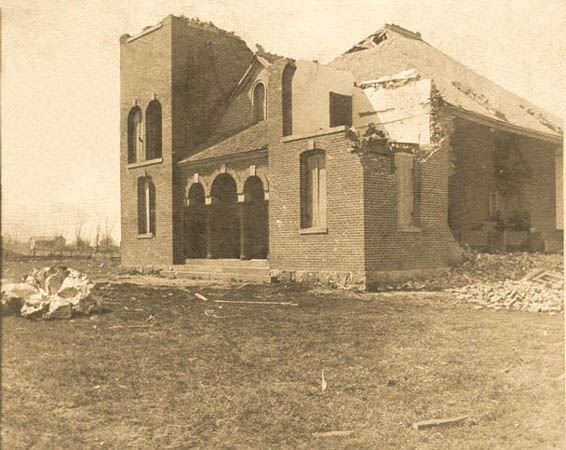
Holy Cross Catholic Church was totally destroyed. The east wall of the church, the side of the building away from the direct force of the wind, exploded from the pressure of the storm leaving the interior exposed. Everything inside was turned topsy-turvy.The church yard was the “safe” landing site for at least three people and a horse who had been picked up by the wind further to the southwest. None were badly injured. Mrs Rose Webster, her son George and boarder Miss Myra Morehouse were all picked up from their home at 1209 E Harrison, blown through the air and deposited, virtually uninjured, at the church. “I was conscious all the time I was flying through the air and it seemed a long time,” Miss Morehouse reported. “I seemed to be lifted and whirled round and round, going up to a great height, at one time far above the church steeples, and seemed to be carried a long distance. As I was going through the air, being whirled about at the sport of the storm, I saw a horse soaring and rotating about with me. It was a white horse and had a harness on. By the way it kicked and struggled as it was hurled about I knew it was alive. I was mercifully landed upon the earth unharmed, saved by a miracle.” Young George, who was directly beneath the horse, “was much afraid I would come in contact with its flying heels.” The horse in question belonged to the Chaneys, a family of teamsters who lived at the intersection of Pierce & Lewis. Mr. Chaney reported he had just come home from work and had put his team in the barn without removing their harnesses. His barn was totally demolished and the flying horse’s team mate killed.
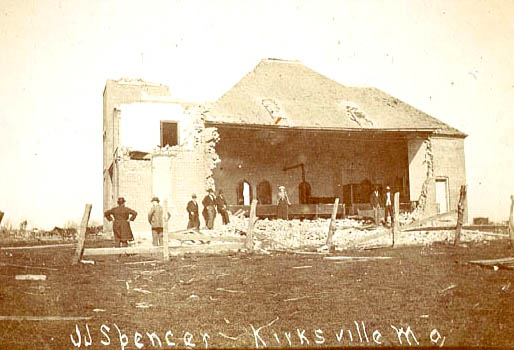
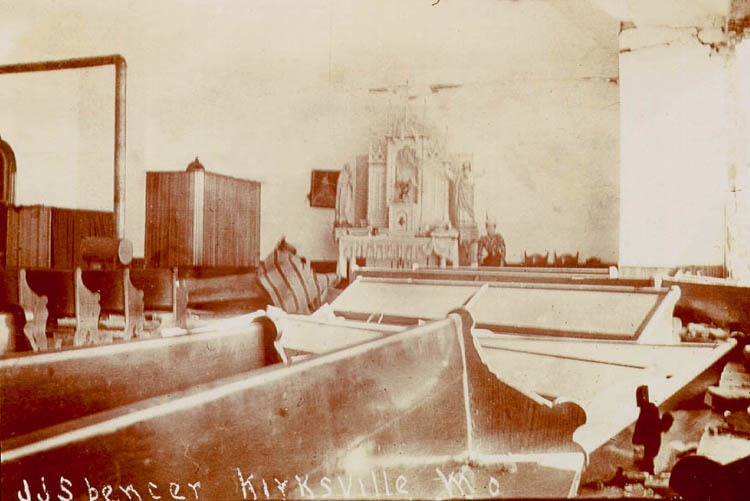
“Down but not out,” Kirksville began rebuilding immediately. Pictures taken from Ward’s Infirmary at the extreme eastern edge of the tornado’s path show the surrounding area on the day after the storm and again a year later. The dome of the Columbian School of Osteopathy appears beyond the rubble at the east side of the building. The westward view in the 1900 photo is one of new homes – and virtually no trees. If you squint, you can see the Courthouse tower on the horizon.
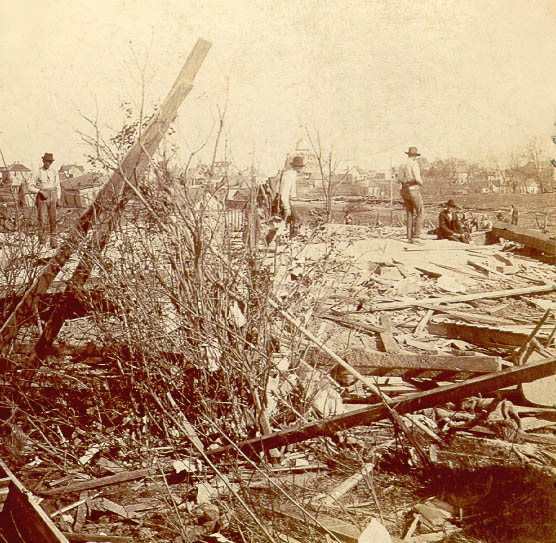
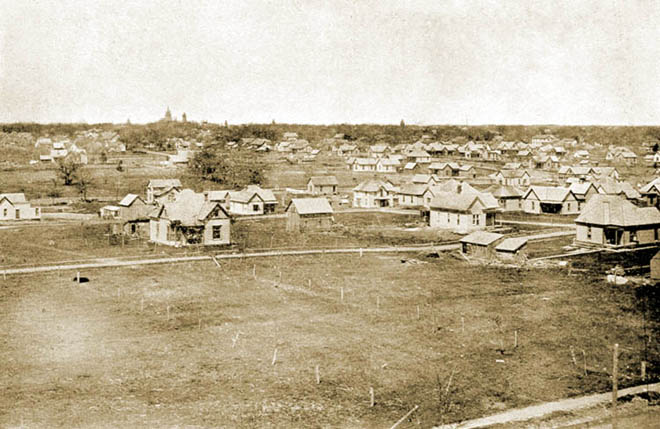
The Kirksville papers in the days following the cyclone described other places damaged or destroyed by the storm and related many interesting, some times horrifying, personal stories about the citizens whose lives were affected, but we unable to illustrate all of them with specific photos.
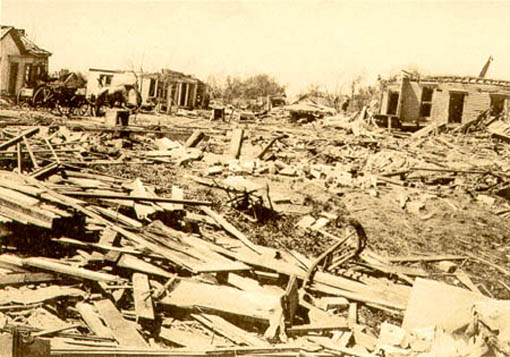
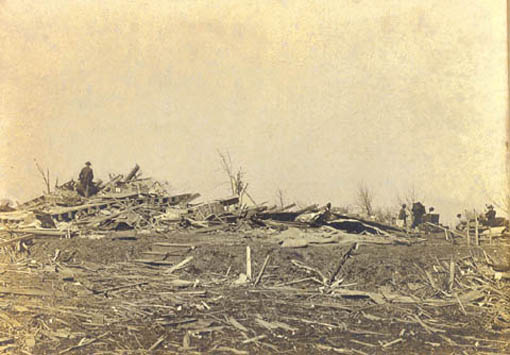
On the other hand, we have pictures in our collection of unidentified locations without stories to describe them; they were taken to record the general destruction the city experienced that evening. These stories and photos are presented together but are not intended to “match”. Cyclones, or tornados, are known to do strange things, occasionally providing their own bit of comic relief in the midst of their destruction. The only picture in this collection that could be considered even remotely humorous is the one below of a vase atop a piano across the room from an intact skeleton — and not a wall in sight! (below) We assume that this was the home of a doctor or medical student.
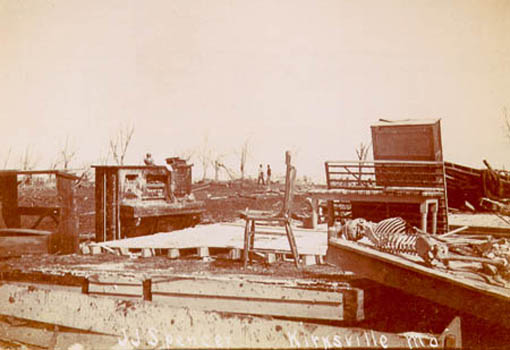
Mrs Patience Hill, age 71, who lived on Baltimore between Harrison & Missouri, was on her way to the cellar when her dress caught in the kitchen door. She grabbed hold of the stock of the pump near the door but it snapped off and she was drawn up into the suction of the storm and dropped back in the same spot. When rescuers found her and were treating her broken leg she expressed happiness for those who had escaped and rebuked those still shrieking with fear.
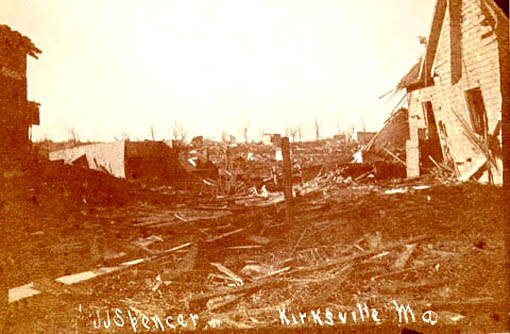
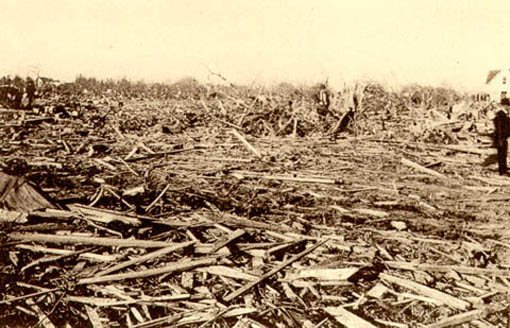
At their home on Missouri, Mrs Edward Rice was ill and unable to leave her bed. Mr Rice placed their two children in bed with her, covered them with carpets and spread himself over the top to hold all down. The house was taken into the air and broken apart and a large section landed on Mr Rice’s back. He sustained extensive spine and rib injuries but his body protected his wife and children and they were unharmed. At the Corner of Harrison & Baltimore, Mr & Mrs Andrew J Glaze were found buried under the ruins of their cottage. Described as “well-to-do”, the elderly couple apparently did not believe in banks. He had $900 in his wallet and she had over $2,000 sewn into the skirt of her dress. Tin roofing from buildings in town landed on J.M. Bohon’s place about 9 miles northeast.


A large linen table cloth and a pillow sham with the monogram “SGG” were found by R.W. Hart on his farm 14 miles out and Mr Yernst found another table cloth about 10 miles east of Queen City. A picture of Captain Craig of the Salvation Army landed at Downing, 25 miles from Kirksville, and the Rice family picture was picked up on a farm near Pulaski, IA, about 60 miles away. An 1877 deed for lots in Kirksville was blown 95 miles to Leando, IA.
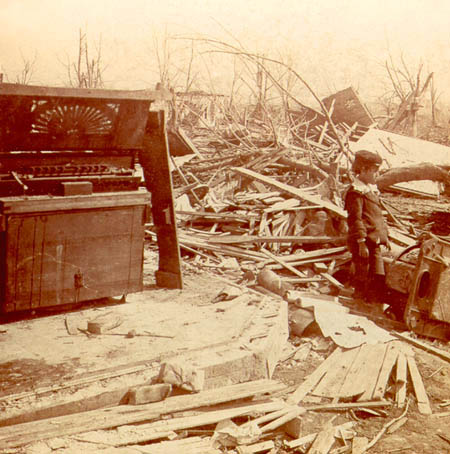
For information concerning this exhibit contact: speccoll@truman.edu